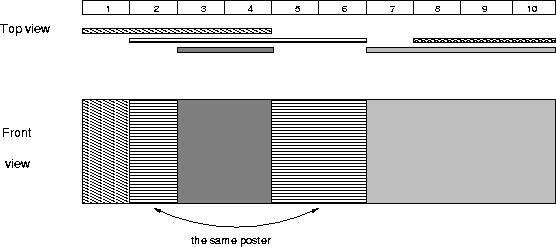线段树区间更新——POJ 2528
对应POJ题目:点击打开链接
Mayor's posters
| Time Limit: 1000MS | Memory Limit: 65536KB | 64bit IO Format: %I64d & %I64u |
Description
The citizens of Bytetown, AB, could not stand that the candidates in the mayoral election campaign have been placing their electoral posters at all places at their whim. The city council has finally decided to build an electoral wall for placing the posters and introduce the following rules:
They have built a wall 10000000 bytes long (such that there is enough place for all candidates). When the electoral campaign was restarted, the candidates were placing their posters on the wall and their posters differed widely in width. Moreover, the candidates started placing their posters on wall segments already occupied by other posters. Everyone in Bytetown was curious whose posters will be visible (entirely or in part) on the last day before elections.
Your task is to find the number of visible posters when all the posters are placed given the information about posters' size, their place and order of placement on the electoral wall.
- Every candidate can place exactly one poster on the wall.
- All posters are of the same height equal to the height of the wall; the width of a poster can be any integer number of bytes (byte is the unit of length in Bytetown).
- The wall is divided into segments and the width of each segment is one byte.
- Each poster must completely cover a contiguous number of wall segments.
They have built a wall 10000000 bytes long (such that there is enough place for all candidates). When the electoral campaign was restarted, the candidates were placing their posters on the wall and their posters differed widely in width. Moreover, the candidates started placing their posters on wall segments already occupied by other posters. Everyone in Bytetown was curious whose posters will be visible (entirely or in part) on the last day before elections.
Your task is to find the number of visible posters when all the posters are placed given the information about posters' size, their place and order of placement on the electoral wall.
Input
The first line of input contains a number c giving the number of cases that follow. The first line of data for a single case contains number 1 <= n <= 10000. The subsequent n lines describe the posters in the order in which they were placed. The i-th line among the n lines contains two integer numbers l
i and ri which are the number of the wall segment occupied by the left end and the right end of the i-th poster, respectively. We know that for each 1 <= i <= n, 1 <= l
i <= ri <= 10000000. After the i-th poster is placed, it entirely covers all wall segments numbered l
i, l
i+1 ,... , ri.
Output
Sample Input
1 5 1 4 2 6 8 10 3 4 7 10
Sample Output
4
Source
题意:就是不断地放某一区间长度的线段,后放的会把前放的覆盖,问最后有多少条线段是可见的(没被完全覆盖的都是可见的)
思路:直接用数组别想了~可以用线段树,但是根太大,要离散化。
离散化下面说得很清楚~秒懂!
通俗点说,离散化就是压缩区间,使原有的长区间映射到新的短区间,但是区间压缩前后的覆盖关系不变。举个例子:
有一条1到10的数轴(长度为9),给定4个区间[2,4] [3,6] [8,10] [6,9],覆盖关系就是后者覆盖前者,每个区间染色依次为 1 2 3 4。
现在我们抽取这4个区间的8个端点,2 4 3 6 8 10 6 9
然后删除相同的端点,这里相同的端点为6,则剩下2 4 3 6 8 10 9
对其升序排序,得2 3 4 6 8 9 10
然后建立映射
2 3 4 6 8 9 10
↓ ↓ ↓ ↓ ↓ ↓ ↓
1 2 3 4 5 6 7
那么新的4个区间为 [1,3] [2,4] [5,7] [4,6],覆盖关系没有被改变。新数轴为1到7,即原数轴的长度从9压缩到6,显然构造[1,7]的线段树比构造[1,10]的线段树更省空间,搜索也更快,但是求解的结果却是一致的。
离散化时有一点必须要注意的,就是必须先剔除相同端点后再排序,这样可以减少参与排序元素的个数,节省时间。
离散化我用的是STL里面的map~或者是二分。。。
#include<cstdio>
#include<cstdlib>
#include<cmath>
#include<map>
#include<queue>
#include<stack>
#include<vector>
#include<algorithm>
#include<cstring>
#include<string>
#include<iostream>
const int MAXN=10000+10;
#define ms(x,y) memset(x,y,sizeof(x))
using namespace std;
int color[MAXN*8];
int vis[MAXN];//vis[i]=1表示i海报已经存在
int ll[MAXN];
int rr[MAXN];
void down(int rt)
{
if(color[rt])
{
color[rt<<1]=color[rt];
color[rt<<1|1]=color[rt];
color[rt]=0;
}
}
void updata(int rt, int left, int right, int l, int r, int col)
{
if(left==l && right==r){
color[rt]=col;
return;
}
down(rt);
int mid=(left+right)>>1;
if(mid>=r) updata(rt<<1, left, mid, l, r, col);
else if(mid<l) updata(rt<<1|1, mid+1, right, l, r, col);
else{
updata(rt<<1, left, mid, l, mid, col);
updata(rt<<1|1, mid+1, right, mid+1, r, col);
}
}
void query(int rt, int left, int right)
{
if(vis[color[rt]]) return; //该海报已存在
if(color[rt]){//该区间都被color[rt]海报覆盖
vis[color[rt]]=1;
return;
}
int mid=(left+right)>>1;
query(rt<<1, left, mid);
query(rt<<1|1, mid+1, right);
}
int main()
{
//freopen("in.txt","r",stdin);
int T;
scanf("%d", &T);
while(T--)
{
map<int ,int>ma;//用map离散化
ms(vis,0);
ms(color,0);
int n;
int i;
scanf("%d", &n);
for(i=0; i<n; i++){
scanf("%d%d", &ll[i],&rr[i]);
if(ma[ll[i]]==0) ma[ll[i]]=1;//判重
if(ma[rr[i]]==0) ma[rr[i]]=1;
}
map<int, int>::iterator it;
int cnt=0;
for(it=ma.begin(); it!=ma.end(); it++){//标序
it->second=++cnt;
}
int col=0;
for(i=0; i<n; i++){
int l=ma[ll[i]];//映射
int r=ma[rr[i]];
updata(1,1,cnt,l,r,++col);//区间更新
}
query(1,1,cnt);
int ans=0;
for(i=1; i<=MAXN; i++)
if(vis[i]) ans++;
printf("%d\n", ans);
}
return 0;
}
#include<cstdio>
#include<cstdlib>
#include<cmath>
#include<map>
#include<queue>
#include<stack>
#include<vector>
#include<algorithm>
#include<cstring>
#include<string>
#include<iostream>
const int MAXN=10000+10;
#define ms(x,y) memset(x,y,sizeof(x))
using namespace std;
int color[MAXN*8];
int vis[MAXN];//vis[i]=1表示i海报已经存在
int ll[MAXN];
int rr[MAXN];
int A[MAXN*8];
void down(int rt)
{
if(color[rt])
{
color[rt<<1]=color[rt];
color[rt<<1|1]=color[rt];
color[rt]=0;
}
}
void updata(int rt, int left, int right, int l, int r, int col)
{
if(left==l && right==r){
color[rt]=col;
return;
}
down(rt);
int mid=(left+right)>>1;
if(mid>=r) updata(rt<<1, left, mid, l, r, col);
else if(mid<l) updata(rt<<1|1, mid+1, right, l, r, col);
else{
updata(rt<<1, left, mid, l, mid, col);
updata(rt<<1|1, mid+1, right, mid+1, r, col);
}
}
void query(int rt, int left, int right)
{
if(vis[color[rt]]) return; //该海报已存在
if(color[rt]){//该区间都被color[rt]海报覆盖
vis[color[rt]]=1;
return;
}
int mid=(left+right)>>1;
query(rt<<1, left, mid);
query(rt<<1|1, mid+1, right);
}
int bsearch(int x, int n)
{
int left=1,right=n;
while(left<=right)
{
int mid=left+((right-left)>>1);
if(A[mid]==x) return mid;
if(A[mid]>x) right=mid-1;
else left=mid+1;
}
}
int main()
{
//freopen("in.txt","r",stdin);
int T;
scanf("%d", &T);
while(T--)
{
ms(vis,0);
ms(color,0);
int n;
int i;
int u=1;
scanf("%d", &n);
for(i=0; i<n; i++){
scanf("%d%d", &ll[i],&rr[i]);
A[u++]=ll[i];
A[u++]=rr[i];
}
sort(A, A+u);
int cnt=1;
int col=0;
for(i=2; i<u; i++) if(A[i]!=A[i-1]) A[++cnt]=A[i];
for(i=0; i<n; i++){
int l=bsearch(ll[i],cnt);//映射
int r=bsearch(rr[i],cnt);
updata(1,1,cnt,l,r,++col);//区间更新
}
query(1,1,cnt);
int ans=0;
for(i=1; i<=MAXN; i++)
if(vis[i]) ans++;
printf("%d\n", ans);
}
return 0;
}
